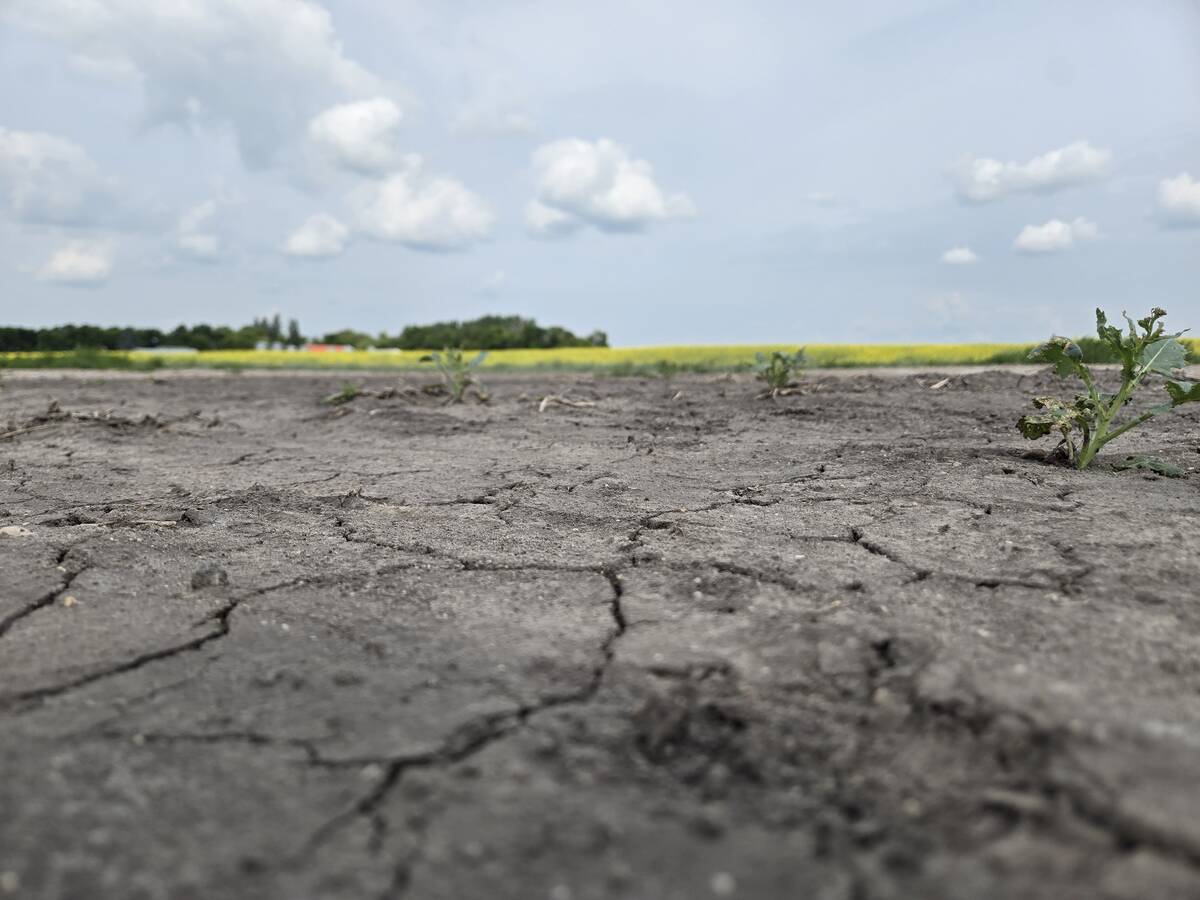As July draws to a close, Manitoba farmers are walking a tightrope between hope and hardship, shaped by highly localized rains and persistent drought stress.
Across the province, crops stand unevenly, with some fields green and filling grain and others stunted and prematurely ripening under dry skies.
“It is truly an uneasy time for many farmers right now with the weather and particularly with the dry conditions,” said Jill Verwey, President of Keystone Agricultural Producers (KAP).
Read Also

Journal pulls long-cited glyphosate study for ethics violations
The journal Regulatory Toxicology and Pharmacology has retracted a 2000 Monsanto-linked glyphosate review, drawing new scrutiny as Bayer faces mounting legal pressure.
WHY IT MATTERS: Manitoba farmers face uneven crops as scattered rain can’t offset widespread drought.
The latest Manitoba Agriculture Crop Report, released on July 22, shows that while isolated areas in the northwest, such as Ruthenia, received more than 40 millimetres of rain last week, many locations in the central, Interlake, and eastern regions saw barely a drop. Season-to-date rainfall remains well below 30-year averages in several areas, particularly around Portage la Prairie and parts of the Interlake. Meanwhile, the province’s Crop Weather Report, released July 20, shows that the Portage area has had only 61 mm of rain since May 1, just 30 per cent of normal.
Regional differences
This variability means every farm has a different story. Kevin Peters, a KAP board member from southeastern Manitoba, said he’s seen a mixed bag of moisture this year, with some dry pockets.
“Fortunately we did catch a bit of rain yesterday [July 22], anywhere from almost nothing to as much as 75 mm if you caught the right cloud. Overall, crops are average to above average in the area, so things are looking pretty good right now,” Peters said at KAP’s July 23 advisory council meeting.
Further north, in the Interlake, the picture is grimmer.
“On our farm, and a lot in the Interlake, it’s been incredibly dry,” said Doug Martin, a farmer in the Selkirk area. “So far, it looks like a slightly below average crop.”
Shannon Pyziak, another Interlake farmer, reported even starker conditions.
“Since spring, there are areas here that have received only about 1.24 inches of total rainfall,” she said. “Crops might look good from the road, but inside it’s a different story. It’s certainly below average, if not well below.”
In Verwey’s Portage area, moisture has been variable.
“We’ve unfortunately missed many of those rain clouds. It’s like we’ve lost the lottery yet another year,” she said.
There’s been a bit more rain in the area recently, but moisture levels are extremely low around both sides of Lake Manitoba.
Even in parts of the southwest and Yellowhead regions, the story shifts field by field, said Tanner Olmstead, an area farmer.
“We’ve had dry spots, and some people got rain. We did have a pretty good hailstorm. Other than that, crops look probably a little below average, but not too bad.”
Things have been “par for the course” in the Yellowhead area, said producer Wyatt Kieper, except in the southern parts of the region near Hamiota, where conditions are much drier.
“Crops are a little late, which is a concern, but overall average to above average, so there’s still optimism, except in those driest pocket,” Kieper said.
Canola challenges
For canola growers, the drought has created a patchwork of conditions even within individual operations, said Nicolea Dow, who farms on the east side of Portage la Prairie.
“Even in my area it, it is a real mixed bag. We have some fields that have gotten decent rains all the way along, and actually look fairly good,” she said. “There’s nice podding coming along.”
However, not all fields are faring as well. Others are very dry, and have faced challenging conditions since spring, including early season pests and high temperatures, which can lead to aborted pods.
“Those are things that we don’t want to see, because that’s lost yield,” Dow said.
Pulse and soybean resilience
For specialty crops like soybeans and pulses, the drought story remains unfinished, with critical weeks ahead determining final outcomes.
“Some areas have gotten more (moisture) than others, and it’s been timely enough, and then in other areas, it’s been dry,” said Terry Buss, production agronomist with Manitoba Pulse & Soybean Growers. “The Interlake probably stands out as one of the most uniformly dry areas.”
Soybeans are currently flowering and beginning to form pods, while dry beans are entering reproduction. Unlike cereals that may have already suffered irreversible damage, these crops still have potential to recover.
“Soybeans can be quite resilient, so they can recover when they’re stressed, and they reproduce for a fair bit of time before they’re done,” Buss said.
Field peas, however, face a different challenge, he added.
“In areas that are too dry, we’re seeing field peas get stressed, start to dry out, start to mature prematurely and definitely yield potential is being hit hard in areas where the rainfall has been enough, because they don’t need a lot of rain, but they need it to be consistent,” Buss said.
Impact of timing and crop type
The timing of rainfall matters as much as the amount, said Ashley Ammeter, a whole farm specialist at Manitoba Crop Alliance.
“For cereals like wheat and barley, the largest amount of water is needed around heading and flowering. If crops have been lacking moisture throughout the season, by the time you reach the grain fill stage, unfortunately, much of the damage has already been done,” Ammeter said.
For longer-season crops like corn and sunflowers, however, rain now could still help create a yield boost, but it’s unlikely that yields will recover completely, Ammeter added.
Managing through uncertainty
As farmers navigate these challenging conditions, many are adjusting their focus from field applications to monitoring, Buss said.
“We’re watching that weather report like every hour…the more rain it wants to throw at us right now, fine, give it to us.”
With parts of Manitoba now facing multiple years of drought, Ammeter said some farmers may consider seeding more drought-tolerant crops, like cereals, especially if soil moisture isn’t replenished over winter. However, changing cropping plans can be challenging for producers that have long-term crop rotations planned.
As crops mature faster under stress, Ammeter expects harvest to start early.
“Farmers may want to leave taller standing stubble to trap snow, and reduce fall tillage to minimize moisture loss,” she said.
Despite widespread drought, Manitoba Agriculture data shows pockets of resilience: in the northwest and parts of the southwest, scattered rains and slightly cooler conditions have helped keep crops filling grains and pastures greener. Growing degree days across most of Manitoba remain above normal, pushing corn and sunflowers into tasseling and flowering stages.
















